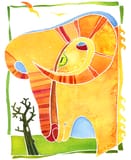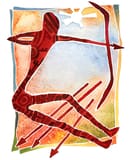The constellation Ophiuchus, the Snake Bearer, crosses the ecliptic, as do the usual 12 Zodiac Signs. Scientists criticize astrology claiming this should be a Sign too. But does this fit with the traditional system of Astrology? Why or why not?
Is Ophiuchus the 13th Zodiac Sign?
OR
Why Astronomers Shouldn't Try to Do Astrology
In 2011, astronomer Parke Kunkle announced the exciting news! There is a 13th zodiac sign! That means your zodiac sign has changed! Right?
Uh, no. Not exactly. In fact, not at all really.
Alas, this is a familiar scenario, ironically almost as predictable as astrology itself.
Every once in a while some astronomer who wants his 15 minutes of fame comes out with some shocking announcement that always reminds me of the old Johnny Carson routine. It goes something like this: "Those astrologers are SO DUMB..." And the media dutifully respond in unison, "How dumb are they?" The astronomer answers, "Those astrologers are SO DUMB, they're using the WRONG ZODIAC!"
The explanation typically given is that the astrological zodiac signs don't line up with the constellations. The astronomer then gets to walk away very satisfied that they have once again proven that astrology is bunk and that only moronic idiots would even entertain the idea of its validity.
In truth, these pronouncements only serve to demonstrate just how little astronomers actually know about real astrology. This latest "revelation" by Parke Kunkle—that the zodiac contains not 12 but 13 signs—is little more than a slightly varied dance step to the same old tired tune.
Mr. Kunkle does have one thing right: the ecliptic (path of the Sun through the heavens) does intersect more constellations than the 12 corresponding zodiac signs that astrology uses. And the Sun does indeed move through a substantial amount of the constellation Ophiuchus, the Serpent Bearer. (Pronounced "Oh-FYE-ah-cuss" or maybe "Oh-fee-YOO-cuss")
Most astrologers who've been practicing their craft for a while are aware of this. What Mr. Kunkle and most other astronomers are not aware of, sadly, is that astrology does not typically measure the zodiac signs by the physical constellations.
Tropical Zodiac versus Sidereal Zodiac
The zodiac used by modern Western astrology is based on the seasons, not the constellations of the fixed stars. The seasons are measured by the tilt of the Earth in its orbit around the Sun, as the Sun's direct line of light moves farther north or south of the Earth's equator.
When the Sun crosses the equator heading north, this is called the Vernal Equinox. This event starts the spring season in the north and the fall season in the south. It also marks the moment when the Sun reaches the beginning of Aries in the Tropical zodiac system. This is the zodiac used in Western astrology and is used by Evolving Door Astrology.
However, it is also true that the Tropical zodiac is not aligned with the constellations. Due to the extremely slow wobble of the Earth, the Equinox aligns with a different point in space against the backdrop of the stars each year. The Aries point (zero degrees of Aries, or the position of the Vernal Equinox each year) shifts ever so slowly in "retrograde" motion (or in a counter-zodiacal direction), moving a mere one degree every 72 years and taking about 26,000 years to go full circle.
This gradual shifting is called the Precession of the Equinoxes, and is where we get the concept of the Age of Aquarius. The Aries point has moved backwards (precession) from the Aries constellation through the constellation of Pisces, and will eventually move into the constellation of Aquarius.
When will the Age of Aquarius begin? The time when the Aries point moves from one sign to another is a matter of much debate among astrologers. I won't go into the issues here, but suffice it to say there are many ways to measure where the boundary lines are between constellations when considering this precession factor in astrology.
In the Eastern system of astrology that is based primarily in India, the zero point of Aries is more closely aligned with the stars and constellations and is called the Sidereal zodiac. In this system, when the Sun is at zero Aries, it is at the same point in space against the backdrop of the fixed stars.
Precession is therefore not a factor in the Sidereal zodiac system, since the zodiac moves in sync with that retrograde motion. This is different from the Tropical zodiac where there is an ever-widening gap between the zodiac signs and the constellations of fixed stars.
Zodiac Signs versus Constellations
So, when the latest media-hungry astronomer announces that "Your sign isn't what you think it is," they're actually referring to the fact that the Tropical zodiac system is not aligned with the constellations. And this is correct.
The truth is that the constellations themselves are merely a group of fixed stars that happen to be aligned in a certain way from our perspective. As an example, if you stand on the street where you live and look at the trees or buildings across the street, they are positioned a certain way in relation to each other. But if you walk up the street about 2 or 3 houses away and look at those same things, they will be aligned in your line of sight very differently. That tree that looks like it's right next to the house across the street is actually in the next block over, so it will be far away from that house when you look at it from a different location.
When we're talking about the stars, these alignments are called asterisms. All constellations are asterisms—groupings of stars that appear to be close together from our perspective, but to an alien living in a different location in our galaxy, those same stars are likely to appear very differently and not necessarily anywhere near each other.
So in astrology, the constellations themselves are more like a reference point for the synchronous correlations between the movements of the planets and our human behavior and experience. In astronomy, they are a reference system for gauging the positions of celestial objects in the sky, seen solely from the perspective of physical science.
Constellations are also not conveniently spaced 30 degrees apart, the way zodiac signs are in astrology. However, the 360 degrees of the zodiac circle does divide nicely into 12 equal sized segments (the signs), and those 12 signs can be categorized neatly into 4 elements (3 signs each of Fire, Earth, Air and Water) and 3 modalities (4 signs each of Cardinal, Fixed and Mutable) and 2 polarities (6 alternating signs of Masculine/Yang/Positive and Feminine/Yin/Negative). These categories come together to form the system of astrology from which interpretations can be derived in an elegant, relevant and meaningful way.
What astronomers typically don't understand (since so few of them ever bother to learn anything about real astrology, and fewer still who do so with an open mind) is that the Tropical zodiac is not based on the constellations, as such. Neither are most Sidereal zodiac systems.
It's true that the zodiac signs are named after the constellations, and were aligned to some extent with their corresponding constellations at one time long ago. However, like all systems of knowledge and understanding, the modern astrology system that evolved from these ancient times has moved far beyond its original roots.
Star Based Astrology
There are some branches of modern astrology that work more directly with the positions of the stars. One area looks at how the zodiacal positions of the planets align with those of the individual fixed stars. When your natal planet is conjunct a fixed star, it becomes colored by the energy or theme associated with that star.
There are also some astrologers who have experimented with using a purely constellation-based zodiac, working with the asterisms of the stars rather than a more ordered geometrical system. However, this is a very off-the-beaten-track way of approaching astrology.
Since modern Western astrology uses the seasonal Sun-Earth alignments to measure its zodiac, this "misalignment" based on the precession of the equinoxes does not affect Western astrology. For the most part, it's a non-issue. There are some astrological techniques that are sometimes used by Western astrologers that take precession into account, but this is not a primary factor in the zodiac system we use.
Ophiuchus ~ the 13th Zodiac Sign?
So does the fact that Ophiuchus intersects the ecliptic mean that there are actually 13 signs in the zodiac? No, this will not change the system of 12 signs in current use. Perhaps some astrologers who like to experiment with unusual approaches to astrology might try experimenting with this new constellation (and some no doubt already have).
However, it's not likely to affect mainstream astrology anytime soon. You can go ahead and continue to read your daily horoscopes as always, and track the planetary movements through the usual 12 signs.
Bottom line? Astrology is just a lens to view our human nature. Different zodiacs and different astrology systems are just different lenses that show us a different view of who we are. You are who you are, regardless of which lens you look at yourself through.
So, by all means enjoy exploring the signs — Tropical, Sidereal, constellations and more. Just don't fall into the trap of thinking that some new "discovery" automatically negates previously established systems of astrology. There's room enough in the universe for all of us. Even astronomers who don't know astrology. ;-)
Further Reading: Deborah Houlding of Skyscript has an excellent article on this subject: Understanding the Zodiac ~ and Why there REALLY are 12 Zodiac Signs, Not 13
© Wendy Guy 2011, all right reserved. Beyond brief quotes or strictly personal purposes, please obtain written permission from the author before reproducing this article. Public domain image of Ophiuchus from WikiCommons.














